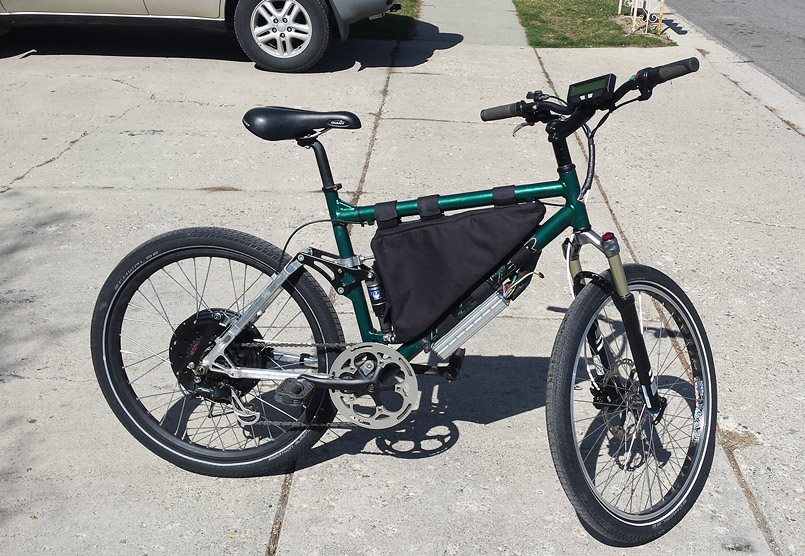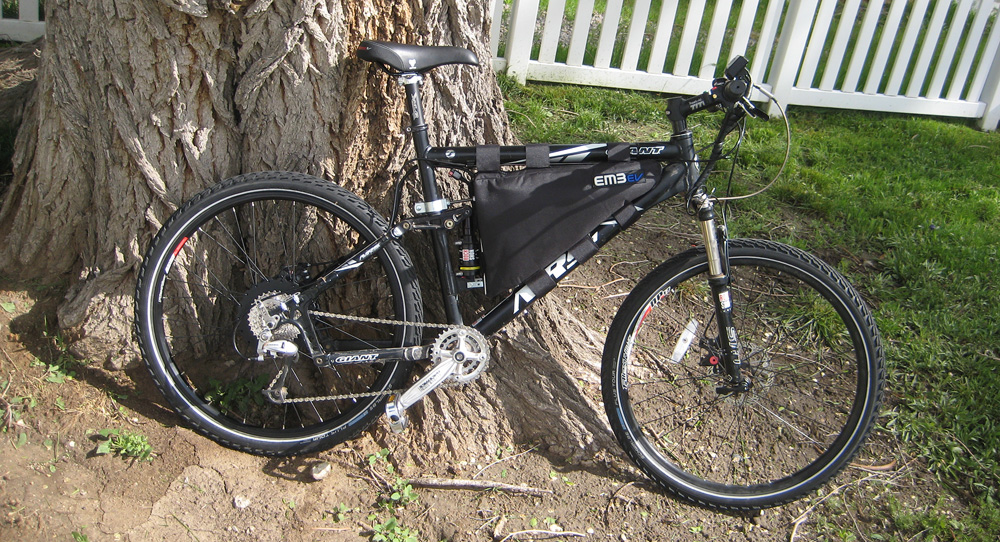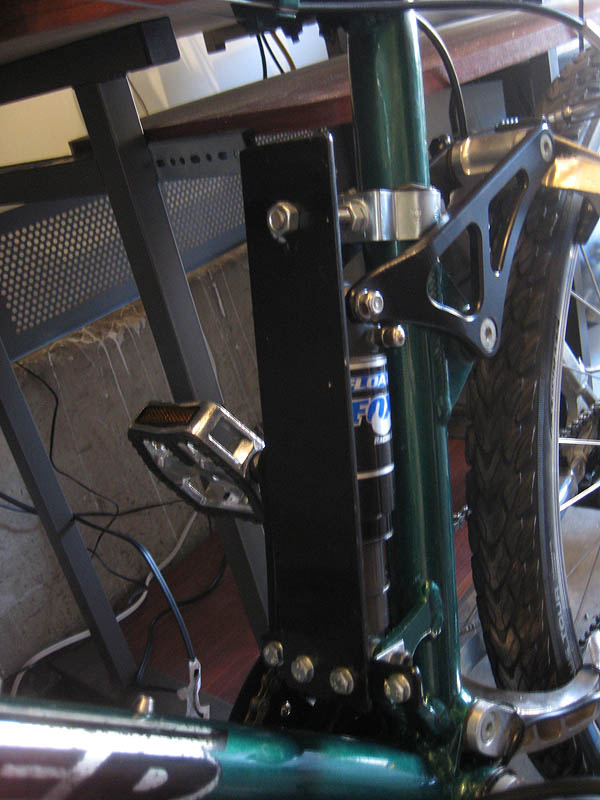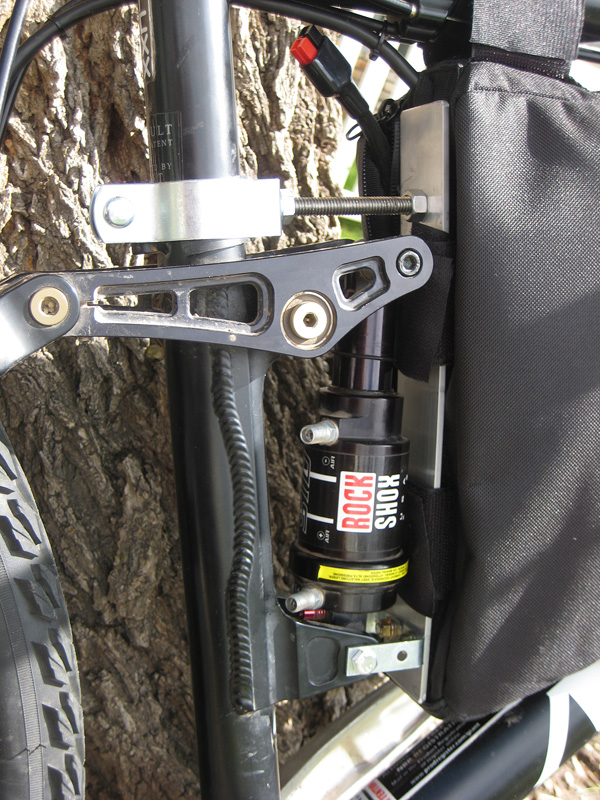spectastic
1 mW
- Joined
- Jul 24, 2017
- Messages
- 18
I dabbled with idea of electric motorcycles for a little bit and decided that bicycles would be WAAAYYY easier and more practical. Why waste 3x the amount of energy going 60 mph when you can get 3x the amount of range going 30 mph, and not have to worry about a bunch of safety gear? So I have in my head the design for the bike I want to build, and I'd like to run this by people with practical knowledge for any advice/critiques.
This is the bike I want to convert.
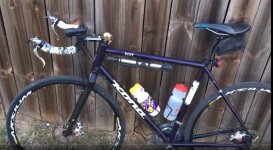
the bike:
- It's a steel frame
- I'd like to take full advantage of the frame triangle for battery space
- I would also like to retain the road style geometry for better aerodynamics compared to a wide mountain bike geometry.
- I plan to upgrade the disc rotors from 180mm to 203 mm for more stopping power.
- I plan to run thicker (maybe 35-38 mm) tires, and get beefier wheels with 32 spokes
the motor:
- I'm thinking about a 1000w front hub motor that's capable of 500+w continuous.
- I can produce about 200-250W, so maintaining 30 mph shouldn't be an issue ime as a competitive cyclist
- I'm still undecided about the front vs rear hub. I think the front hub is a simpler design, where I can replace the wheel easily. It would also allow me to retain the 10 speed cassette in the back instead of the 7-8s freewheel that comes with most rear hub motors.
- front hub would also help slightly with weight distribution. otoh, I'm not sure how front hub motors would handle at 30-40 mph.
- regardless of whether I go with front/rear hub, I figure it's probably a good idea to get a suspension fork instead of the rigid steel fork that I have for it. and if I decide to go with front hub, then perhaps thru axle is even better. the question I have here is whether it's even needed for pavement, and whether it will significantly affect the efficiency of the bike.
the battery
- I'm thinking of a 48V battery pack. However, there are some questions there, of how to build/buy a cost effective battery pack that conforms to the shape of the frame's triangle
- should I go with 18650 pack? if so that'd involve spot welding, which i don't have. however, this might be the cheapest option
- I'm uncertain which chemistry to go with right now. LFP is the cheapest and likely carries the most longevity. however, they likely charge slower, and aren't as energy dense. NCM is the most energy dense, but are expensive and deteriorates faster
- leading to the previous point. how important is having a BMS for a 48V system? Can you mitigate overcharging and capacity fade issues by having a good BMS? I'm pretty clueless when it comes to that area
- I'm curious whether there are other options as well, like modules you can buy.
- Perhaps there'd even be the option to add on an extra pack for longer trips.
- I'd like for there to be the option to stop charging the battery when the cells are at 80%, in order to prolong their capacity.
- how much capacity do you reckon I can reasonably stuff in there? 2-3 kWh?
the other stuff:
- i'm totally clueless when it comes to controller, bms, display, etc. I just know they need to fit together somehow. still need to do some research in this area, but I'm open to suggestions as to what's popular
- I would like there to be 2-3 different pedal assist modes, where I can set something like: mode 1 = 250W, mode 2 = 500W, mode 3 = 700W. and the input for the pedal assist would be forward crank motion, so maybe a hull effect sensor with a magnet rotor or something like that?
sorry for the long essay. but based on what I wrote, any feedback/tips would help. This is just a thought exercise for now, and I probably won't get to it until at least a couple of months from now. Thanks!
This is the bike I want to convert.

the bike:
- It's a steel frame
- I'd like to take full advantage of the frame triangle for battery space
- I would also like to retain the road style geometry for better aerodynamics compared to a wide mountain bike geometry.
- I plan to upgrade the disc rotors from 180mm to 203 mm for more stopping power.
- I plan to run thicker (maybe 35-38 mm) tires, and get beefier wheels with 32 spokes
the motor:
- I'm thinking about a 1000w front hub motor that's capable of 500+w continuous.
- I can produce about 200-250W, so maintaining 30 mph shouldn't be an issue ime as a competitive cyclist
- I'm still undecided about the front vs rear hub. I think the front hub is a simpler design, where I can replace the wheel easily. It would also allow me to retain the 10 speed cassette in the back instead of the 7-8s freewheel that comes with most rear hub motors.
- front hub would also help slightly with weight distribution. otoh, I'm not sure how front hub motors would handle at 30-40 mph.
- regardless of whether I go with front/rear hub, I figure it's probably a good idea to get a suspension fork instead of the rigid steel fork that I have for it. and if I decide to go with front hub, then perhaps thru axle is even better. the question I have here is whether it's even needed for pavement, and whether it will significantly affect the efficiency of the bike.
the battery
- I'm thinking of a 48V battery pack. However, there are some questions there, of how to build/buy a cost effective battery pack that conforms to the shape of the frame's triangle
- should I go with 18650 pack? if so that'd involve spot welding, which i don't have. however, this might be the cheapest option
- I'm uncertain which chemistry to go with right now. LFP is the cheapest and likely carries the most longevity. however, they likely charge slower, and aren't as energy dense. NCM is the most energy dense, but are expensive and deteriorates faster
- leading to the previous point. how important is having a BMS for a 48V system? Can you mitigate overcharging and capacity fade issues by having a good BMS? I'm pretty clueless when it comes to that area
- I'm curious whether there are other options as well, like modules you can buy.
- Perhaps there'd even be the option to add on an extra pack for longer trips.
- I'd like for there to be the option to stop charging the battery when the cells are at 80%, in order to prolong their capacity.
- how much capacity do you reckon I can reasonably stuff in there? 2-3 kWh?
the other stuff:
- i'm totally clueless when it comes to controller, bms, display, etc. I just know they need to fit together somehow. still need to do some research in this area, but I'm open to suggestions as to what's popular
- I would like there to be 2-3 different pedal assist modes, where I can set something like: mode 1 = 250W, mode 2 = 500W, mode 3 = 700W. and the input for the pedal assist would be forward crank motion, so maybe a hull effect sensor with a magnet rotor or something like that?
sorry for the long essay. but based on what I wrote, any feedback/tips would help. This is just a thought exercise for now, and I probably won't get to it until at least a couple of months from now. Thanks!


